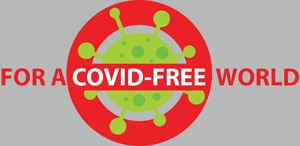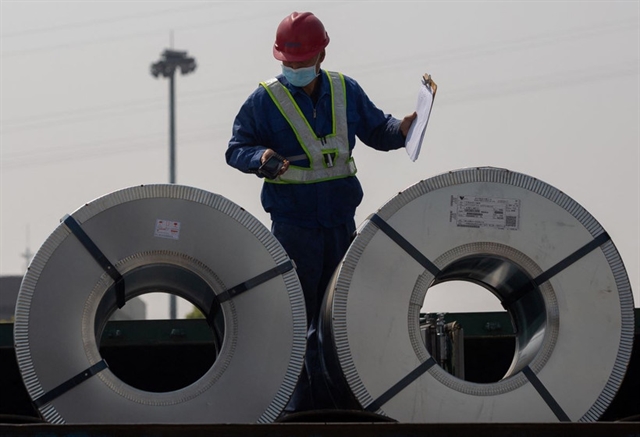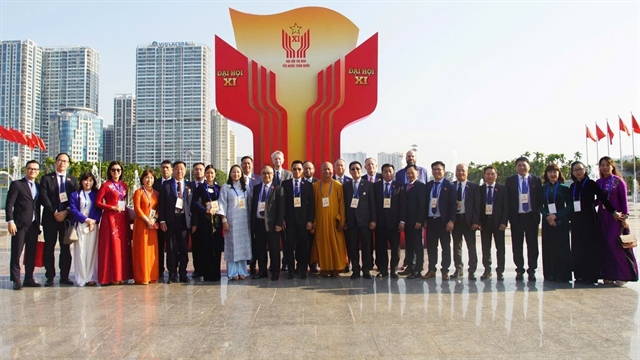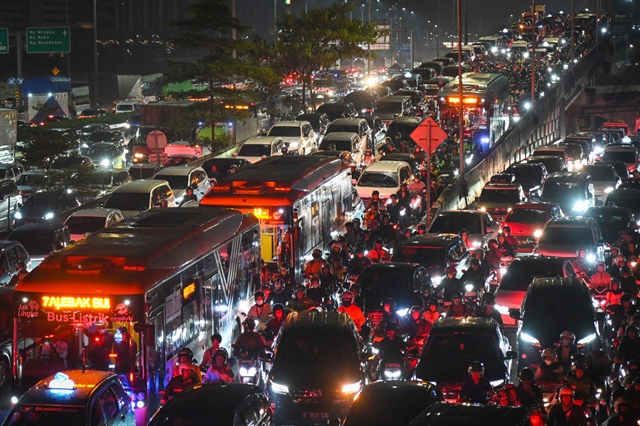 Society
Society

This week begins with good news: HCM City authorities announced that the country’s pandemic hotspot has contained its largest-ever COVID outbreak and is ready to reopen the economy.

|
| Workers have come back to work at Bowker Việt Nam Company in Đồng An 1 Industrial Zone, Bình Dương Province. VNA/VNS Photo Chí Tưởng |
Thu Vân
This week begins with good news: HCM City authorities announced that the country’s pandemic hotspot has contained its largest-ever COVID outbreak and is ready to reopen the economy.
The city has also closed some COVID-19 field hospitals located at dormitories and schools as the number of cases has dropped in recent weeks.
Even though the pandemic is far from over, things are looking up.
With the Government determining to stop localities from setting policies inconsistent with regulations set by the central government, Resolution 128, after more than 10 days since being issued, has brought about relief for any business operating in Việt Nam after a long period of social distancing measures through different directive levels.
The most worrying problem for any country is the fear of resurgence of the pandemic after reopening the economy (and we’ve known examples of many), but as the level of vaccine coverage among adults in Việt Nam increases, the Government has asked localities to reach a consensus to implement policies throughout the country, getting rid of restrictions even higher than the central government’s and causing negative impacts on people’s lives, and businesses’ operations.
With clear criteria, consistent and transparent application of COVID-19 restrictions, Resolution 128 has allowed localities to identify their risk levels and follow the do's and dont's accordingly.
By October 21, all 63 provinces and cities nationwide announced their pandemic levels, with 26 of them being “green” – which means they are at low risk of transmission and most activities can resume. As many as 37 provinces are in “yellow” – average risk of transmision. And yes, we have no more orange and red areas.
Authorities in Khánh Hoà and Bà Rịa-Vũng Tàu provinces earlier this week reopened public beaches and restaurants in Nha Trang City and Vũng Tàu City, respectively, with restrictions.
And these localities are not alone.
Northern Quảng Ninh Province took the first steps by cancelling the requirement for people entering the province to show negative PCR (polymerase chain reaction) testing results within the last 72 hours. It also removed the regulation that Quảng Ninh’s residents have to have a test before leaving the locality and returning.
Bình Dương Province scrapped the regulation asking workers to have the full two doses of COVID-19 vaccine or putting those coming from other localities in 7-day quarantine.
According to the province’s Department of Industry and Trade, the province has allowed businesses to conduct tests and issue certificates for workers to travel, facilitating the mobility of workers and experts between Bình Dương and HCM City.
Along with that, the province’s authorities also helped businesses to access sources to buy qualified COVID-19 test kits at reasonable prices. It is expected that in October, 100 per cent of its workers will be fully vaccinated.
For Hải Dương those coming into the province from localities with risks of level 1, 2 and 3 (green, yellow and orange) don’t need to show a negative test for SARS-CoV-2. Only those with suspected symptoms are asked to take a test.
Firms are now more confident to welcome the workforce returning to their normal business activities while trying to maintain prevention measures at work place and taking appropriate strategies in line with the Ministry of Health’s guidance.
As of October 20, Hà Nội has reopened 95 per cent of its industrial zones.
Approximately two-thirds of industries in HCM City have reopened. The number of businesses in export processing zones and industrial parks in HCM City resuming operations has reached approximately 66 per cent, while at the City’s Saigon Hi-Tech park the rate is 74 per cent.
By October 15, more than 82 per cent of enterprises in industrial zones in Đồng Nai Province have resumed operation, with more than 54 per cent of their workers coming to work.
All enterprises in industrial zones in Bình Dương Province have resumed operations, though the capacity has only reached 44 per cent compared to before the pandemic.
Even though a pre-pandemic state might take a long time to come, the darkest days are over. While small outbreaks and COVID-19 variants are possible in the future, the Government’s new guidance provides a clear basis to help localities implement pandemic prevention and control measures in a unified, synchronous manner and with minimum impacts on people’s health and businesses’ operations.
The business community highly welcome the move.
Trần Việt Anh, General Director of Nam Thái Sơn Import-Export Joint Stock Company, said that the most important point of Resolution 128 was to help businesses define their operational status more clearly in the new context.
Việt Anh said at the end of September, he had to make a bold decision to transfer a part of export orders to "rivals" to keep commitments with partners. But at the same time, the difficulty was that businesses did not know the Government's long-term pandemic prevention and control plan to build their own production plans.
“I couldn't predict when to start production again, so that put my foreign customers in a passive situation as well, it was very likely that they could stop doing business with me and find another supplier. Now that Resolution 128 has clearer regulations, longer-term scenarios can be seen,” he said.
Nguyễn Văn Bé, Chairman of the Association of Export Processing Zones and Industrial Zones in HCM City, said that when it was determined to step in to restore production, the most expected thing for businesses was to solve the problem of smooth circulation of goods.
“Therefore, the introduction of Resolution 128 is very timely, creating a common mechanism for localities, helping businesses quickly go into production and complete the year-end plan,” he said.
Chief Representative of the German Industry and Commerce in Việt Nam (AHK Viet Nam) Marko Walde said as long as the guidelines are national and there is not a different in applying from province to province and between localities the enterprises should have no obstacles in implementing the resolution.
Support in labour shortage
When the lockdowns were lifted, thousands of workers returned to their hometowns for fear of another outbreak and resulting lockdowns. According to the General Statistics Office (GSO), about 1.3 million labourers returned to their hometowns between July and September 15.
This has posed additional challenges for businesses and factories that want to resume production.
The Government has thus issued and supplemented many policies to support labourers and enterprises.
The Ministry of Labour, Invalids and Social Affairs is making plans to restore the labour market, according to which it will make sure employees can work in safe conditions with full vaccination. At the same time, the Government is also providing transportation from the provinces back to production sites to resume business activity.
The Ministry of Finance has advised the Government to reduce corporate income tax, VAT, personal income tax and waive fines for late tax payment for businesses facing difficulties. This total support package is worth about VNĐ21.3 trillion ($926 million).
Fiscal measures such as extension of loan payment and insurance premium payment, corporate income tax reduction, and exemption of fines on late payment cannot help businesses recover immediately, but they will provide solid support, helping businesses save more cash to maintain production and recover.
Businesses have their own initiatives and efforts in keeping workers, offering incentives such as free COVID-19 tests, hotel accommodation, free meals, and daily stipends to encourage workers to return. They have also given generous benefits to ensure workers remain at their jobs.
As of October 21, 2021, the Ministry of Health confirmed a total of 873,901 cases of COVID-19. However, 796,583 of the affected patients have recovered and been discharged from hospitals.
The Government is developing a roadmap to fully open up to international visitors by June 2022. The plan will be implemented in phases with a pilot programme for fully vaccinated international tourists to Phú Quốc island in November 2021. This is expected to be followed by Nha Trang, Hạ Long, Hội An, and Đà Lạt in December.
Yet we still need to stay vigilant at the new developments of the pandemic in some countries like China (which had to brace for more COVID-19 curbs as a wave of infections raises concerns of a broader outbreak), Singapore (which has extended COVID restrictions to four more weeks after new daily cases hit a record high), or Latvia, (once seen as coronavirus success story but had just become the first country to reimpose lockdown in Europe’s new COVID wave).
Hopefully, with the vaccine rollout picking up pace and the whole community taking responsibility for their health, we will all return to a more normal existence, soon. VNS

|




